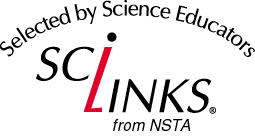|
Antwort an: | <mark_d@nsta.org> "Mark Davis" <mark_d@nsta.org> <b-online@botanik.uni-hamburg.de> NSTA selects your site Fri, 1 Feb 2002 09:17:45 -0500 |
Dear University of Hamburg,
I'm writing to tell you about a new service provided by the National Science Teachers Association and to invite you to help us facilitate the effort. The service is called SciLinks, and it is an endeavor by NSTA to connect textbooks to useful online content
Many teachers are taking advantage of the Internet to show their students materials that enhance or extend the content covered in the curriculum. These materials are available in the public domain, but they are often difficult to find. We believe that by utilizing textbooks as a portal to good online content, we can reach more teachers and students than is possible with the traditional search engine or pointer web site. This is simplified by the fact that 90% to 95% of students learn science through the pages of a textbook. A direct connection from a concept on the textbook page to materials exploring that concept in cyberspace leads readers to the kinds of materials our professional educators believe work best in the classroom.
You are receiving this letter because one of your web pages was selected by our team of teachers who reviewed it using a stringent set of criteria that ensure selected materials have accurate content and effective pedagogy. You can review the criteria they used by visiting
http://www.scilinks.org/nsfinstitute/criteria.htm
Our teachers selected the following web page(s), and identified the following web masters and/or authors as responsible for this page or page:
URL Web master/author
http://www.biologie.uni-hamburg.de/b-online/e02/02c.htm Peter v.
Sengbusch
http://www.biologie.uni-hamburg.de/b-online/e30/30.htm
Once a web site is selected, we place its URL in a database, correlate it to the National Science Education Standards, and write a brief description that identifies one or more of its salient characteristics. When a reader (a teacher, student, or even parent) of a SciLinked textbook comes across a SciLinks icon in their textbook, they know that the content on that page has been enhanced with online content specifically connected to a single concept. The reader goes to the free SciLinks web site, and they type in a code found on the pages of that text, and the SciLinks search engine reports the five to 15 pages our teachers selected.
When a user selects one of these sites, a new browser window opens, points to the selected web site, and connects the reader directly to the content provider--you.
We hope you find this connection useful. If you would prefer to not be included in the site for any reason, please write me, and I'll remove your page from the database. On the other hand, should you agree that this is a useful way to direct students to your online content, then please consider using the attached SciLinks logo somewhere on the selected page(s). You can point from this logo to http://www.scilinks.org/certificate.asp in order to explain to your users the significance of this selection. This will mark your page as one of excellence. If you use the logo would you please include the following: "Selected by the SciLinks program, a service of National Science Teachers Association. Copyright 2001."
If your web page URL changes please let me know so we can update it in our database.
If a web page has been mistakenly attributed to your organization, please zip me a note so that I can track down the actual owner.
If you have additional sites that you would like to submit for review go to the main SciLinks page: http://www.scilinks.org At the bottom of the page there will be a link to the submission page.
Thanks for considering this opportunity to connect teachers and students to the content you have worked so hard to create.
Regards,
Mark Davis
SciLinks
 Selection
Criteria Selection
CriteriaAccuracy: Is the information in the site accurate? Are there political or ideological biases? What motivation does the author have for placing this information on the Net. Authority: Does the site have some reputable organization or expert behind it? Are sources of information stated? Is the information verifiable? Can the author be contacted for clarification or to be informed of new information? (Examining the URL can give clues to the authority of a source. For instance a tilde “~” usually indicates a personal web directory, rather than part of the organization’s official web site.) Currency: How frequently is the site updated? Are revisions stated and do these correspond to the information in the site? Does the organization or person hosting the site appear to have a commitment to the ongoing maintenance and stability of the site. Design (overall): Is the site interesting to look at? Do the visual effects enhance the site, distract from the content, or substitute for content? Interactivity: Where interactive features do the sites provided? Do they add value to the site? Objectivity: What is the purpose of the site? Is the purpose clearly stated? Does the site fulfill its purpose? Quality of writing: Is the text well written? While hypertext linking and multimedia are important elements of the Web, the bulk of the information content on the Web still lies in text, and quality of writing is important for the content to be communicated clearly. Uniqueness: Is the information in this site available in other media (for example other sites, Gopher, WWW, print, CD-ROM)? What advantages does this particular site have? Does the information enhance the textbook information? Workability: Is the site convenient to use? Is the site user friendly? Are any special commands clear? Is help information available? Does the site load quickly and easily? |